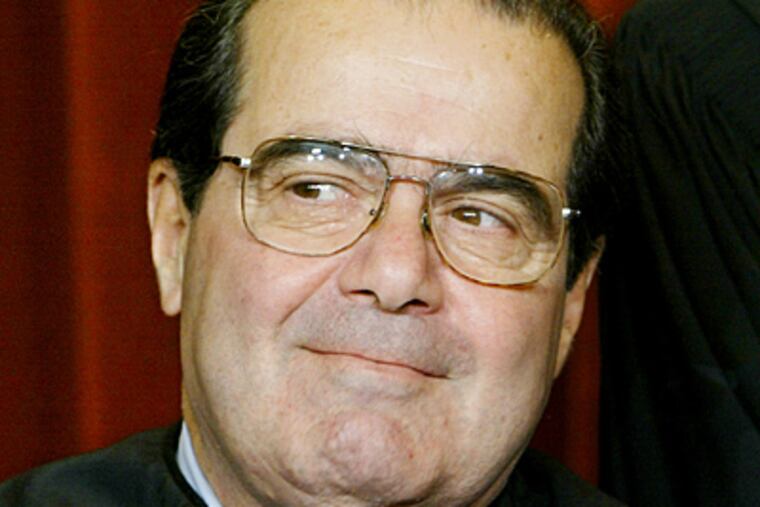The American Debate: A case for TV in top court
Public should see the powerful justices match wits with lawyers.

After much digging, I have unearthed an issue that draws bipartisan support and landslide public approval. It even puts me on the same side as conservative legal eagle Kenneth Starr.
We believe that U.S. Supreme Court proceedings should be televised.
This seems obvious, right? The nine robed brethren arguably hold the most powerful jobs in government, and they have the final word on virtually every hot-button dispute; as former Pennsylvania Sen. Arlen Specter remarked Tuesday, during congressional testimony, "the court decides who should live in abortion cases, who should die in the death-penalty cases."
Which is why we should be able to observe oral arguments, to see justices match wits with the lawyers in real time. Starr, the famed pursuer of Bill Clinton during the impeachment episode, rightly remarked this autumn that cameras in the high court are "long overdue." We must hold our public servants accountable; the more powerful the servant, the more warranted the scrutiny.
And surely the broadcast of intricate and nuanced argumentation would be the highest and best use of the medium. If Edward R. Murrow were alive, he'd probably say what Specter said Tuesday: "Television should cover the government as well as sports and soaps."
The TV issue has long been moving through the Washington miasma at the speed of a snail, mainly because the justices by tradition bridle at the prospect of transparency, but the issue has now resurfaced with some urgency because C-Span is seeking permission to broadcast the impending oral arguments on the historic health-reform law.
The court hasn't yet deigned to respond, but its hostility is well-established. During a Senate hearing two months ago, Justice Antonin Scalia said that the dumbed-down media would serve up simplicities to the great unwashed: "If I really thought the American people would get educated, I'd be all for it. . . . But for every 10 people who sat through our proceedings gavel to gavel, there would be 10,000 who would see nothing but a 30-second takeout from one of the proceedings, which I guarantee you would not be representative of what we do."
Well, pardon me for questioning the logic of an august thinker, but I have to ask: If the downside of a "30-second takeout" is so serious, then why do we bother to permit TV broadcasts inside the House and Senate, at presidential debates, in many lower federal courts, and in 47 of the 50 state Supreme Courts? Granted, sound bites are inevitable, but shouldn't we have the chance to view them in full context - and judge for ourselves whether the blogs and cable networks are parsing unfairly?
The other big claim is that high court cameras would debase the discourse, that they'd inspire opposing lawyers to "grandstand." This fear has been overblown. A 1994 study by the United States Federal Judicial Center reported that federal judges and lawyers in televised venues cited "small or no effects" on decorum.
And pandering to the cameras would be counterproductive anyway. In congressional testimony Tuesday (at least the fifth time the issue has been aired on Capitol Hill since 2006), attorney Thomas Goldstein said: "As someone who is getting ready to argue his 25th case, I can say that our only concern is persuading the justices, not annoying them and potentially losing votes by grandstanding."
Actually, I suspect the justices' antipathy is rooted in self-interest. They enjoy being both powerful and anonymous. At a conference in 1993, Justice Byron White even said it out loud: "I am very pleased to be able to walk around, and very, very seldom am I recognized. . . . It's very selfish, I know."
It's also about feeling special. The high court justices exempt themselves from the conflict-of-interest rules that ethically bind all lower federal courts, and they continue to resist the TV transparency that is embraced by the highest courts in Canada and Britain and endorsed by 80 percent of Americans in a 2009 Gallup poll. Justice Anthony Kennedy has insisted, "We teach, by having no cameras, that we are different," but it's high time the high court acknowledged that, in Goldstein's words Tuesday, "the United States is culturally a visual nation."
And, heck, maybe a televised court would wind up with an image boost. Gallup says 40 percent of Americans now view the court unfavorably, the second-worst rating in the last 10 years. That number might drop if people get the chance to witness the substantive exchanges. Indeed, Mark Cady, chief justice of the Iowa Supreme Court, said Tuesday that cameras had been a PR win in his bailiwick: "The more the public sees our courts operate, the more they like and respect the court system."
But since, in Kennedy's words, the high court operates "on a different time line" than ours, it's not likely to OK televised arguments on the health-reform law. Which is a shame, if only because Clarence Thomas might be prodded by the camera's presence to ask a question for virtually the first time in five years. That alone would be great TV.